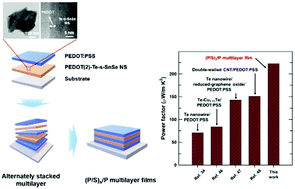Thermoelectric enhancement in multilayer thin-films of tin chalcogenide nanosheets/conductive polymers†
Abstract
Te-Substituted SnSe nanosheets (Te-s-SnSe NSs) with a lateral size of ∼500 nm are fabricated and their surfaces are then coated with a poly(3,4-ethylenedioxythiophene) PEDOT nanolayer. The 3,4-ethylenedioxythiophene loading is optimized for achieving outstanding thermoelectric performance and the resulting PEDOT-coated nanosheets (PEDOT-Te-s-SnSe NSs) are alternately stacked with PEDOT:poly(styrenesulfonate) (PSS) using a solution-processable method to obtain multilayer inorganic/organic composite films. The as-fabricated multilayer films exhibit outstanding electrical conductivity and Seebeck coefficient. This is due to the enhanced interchain interaction and charge-carrier hopping of the stretched PEDOT chains as well as the presumable energy-filtering effect at the interfacial potential barriers between inorganic and organic layers. The multilayer film consisting of three-repeated stacking allows a maximum thermoelectric power factor of 222 μW m−1 K−2, which is 5.5 times larger than that achieved with pristine PEDOT:PSS. This strategy of combining inorganic and organic materials into multilayer films is promising for the achievement of high-performance thin-film thermoelectrics.



 Please wait while we load your content...
Please wait while we load your content...